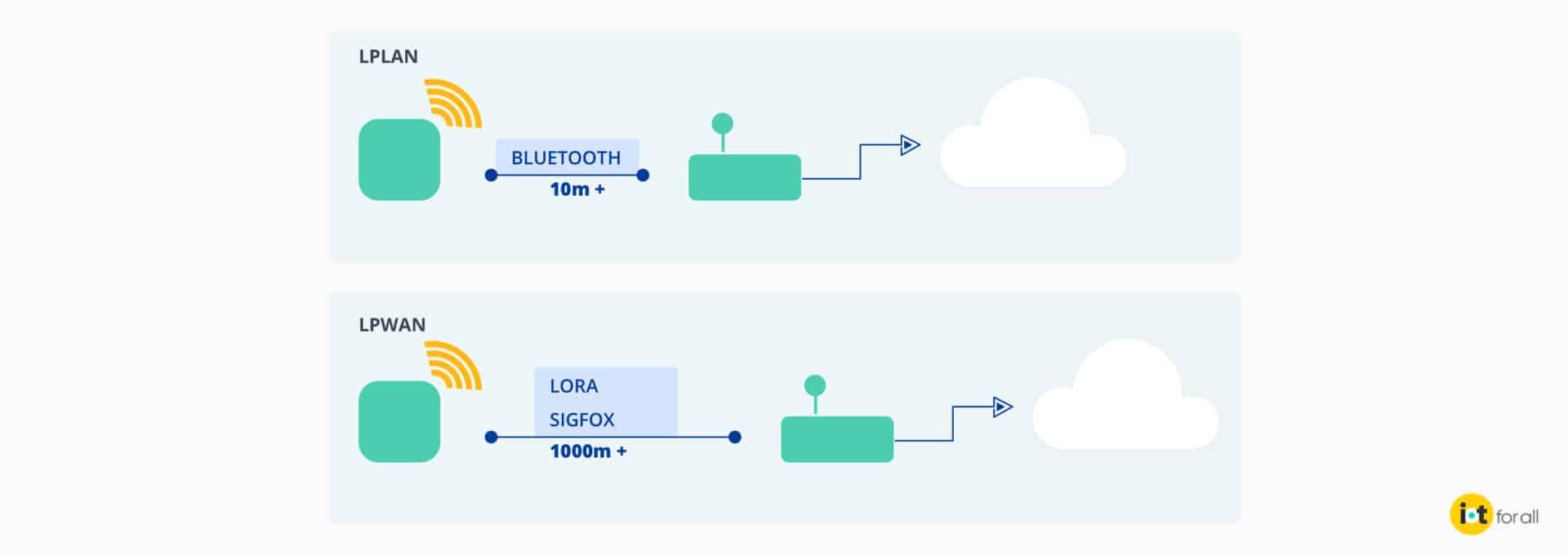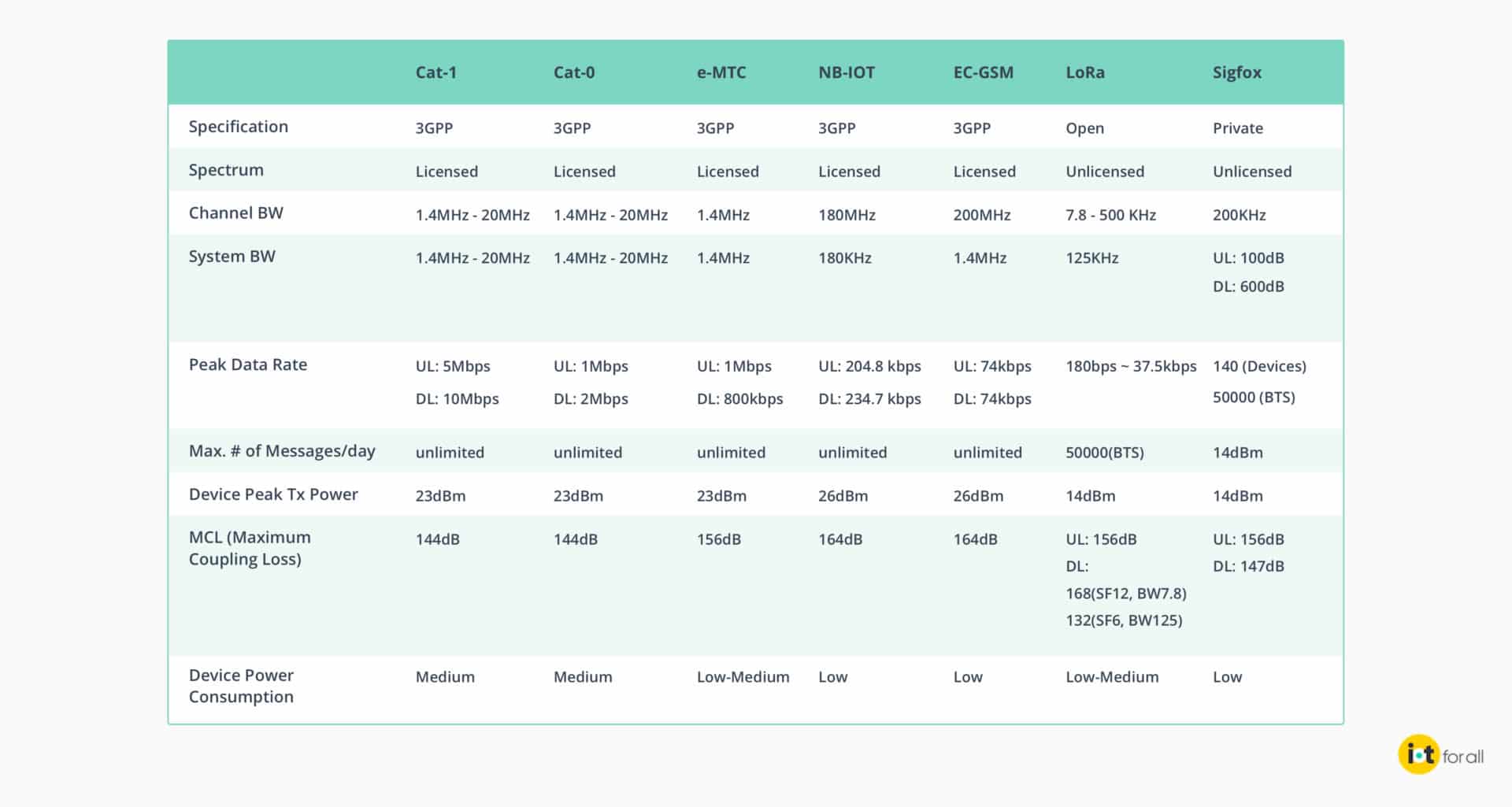What is LPWAN and the LoRaWAN Open Standard?
What is LPWAN and the LoRaWAN Open Standard?
- Last Updated: December 2, 2024
Michael Wedd
- Last Updated: December 2, 2024



Many Internet of Things applications require that data be gathered and sent across long distances, with sensors sometimes being miles away from each other. For IoT deployments that work in agriculture settings or in warehouses, devices may be required to transmit small packets of information periodically for years or even a decade on a single battery charge. Enter LPWAN.
But those remote, long-term, spread-out IoT applications face a problem of simple physics: if you want to transmit information wirelessly over long distances, you have to either increase signal power or decrease signal bandwidth. Consider this: if water is flowing through a pipeline, and you want to send it further away from the source, you either have to increase the pressure (power) behind the water or use a narrower pipe (bandwidth)—or both.
The latter physical problem inspired a certain class of wireless networks: the “Low Power Wide Area Network” or “LPWAN” (sometimes "LPWA"). You may have heard the terms LPWAN and LoRaWAN before without knowing what they are. You might be wondering, what is LPWAN? What is LoRaWAN? Why do they matter? In this article, I’ll introduce LPWAN before focusing on one particular LPWAN protocol: the LoRaWAN open standard.

Image Credit: ReelyActive
A Brief History of the LPWAN Landscape
Sigfox popularized LPWANs in the 2000s as a highly effective alternative to the power requirements and licensing costs of cellular networks. A French startup, Cycleo, developed some compelling low-power RF semiconductor IP and Semtech acquired them in 2012 to consolidate their low-power RF portfolio. Semtech now controls some of the core IP underneath the LoRa protocol, which has become the de facto non-cellular LPWAN protocol, although Sigfox recently announced a new global (re)expansion.

Image Credit: Link Labs
The major cellular carriers and 3GPP, the global cellular standards body, weren’t happy with the way Sigfox and Cycleo (Semtech) had created IoT-specific LPWANs, isolating cellular players from the LPWAN market—a market that had started to attract a lot of industrial clients. 3GPP started standardizing and popularizing LTE-Cat M1 and NB-IoT (Narrowband IoT) as cellular LPWANs that operate mostly within licensed bands.
Cellular IoT is becoming increasingly popular for IoT systems that for almost a decade would’ve been designed as non-cellular LPWANs, however, LoRaWAN is still going strong. Semtech—with obvious potential bias—predicts that by 2019 as much as 40 percent of LPWANs will run on LoRa (we’ll dive into LoRa later).
5G is poised to shake up the entire LPWAN landscape. It promises low-latency, low-power, and high data transfer rates—a previously unattainable combination. 3GPP is also considering allowing 5G technologies to operate in the unlicensed bands—specifically, 3.5 GHz, 5 GHz, and 60 GHz—further encroaching upon non-cellular LPWANs. However, since 3GPP is only now finalizing the standards, and Verizon and AT&T are just starting to pilot the first 5G networks, much remains to be seen.
LPWAN as a Solution
Basically, LPWANs allow solutions providers to design IoT systems for Applications that require devices to send small amounts of data periodically over often-remote networks that span many miles and use battery-powered devices that need to last many years.
LPWANs achieve that feat by having their IoT devices send only small packets of information periodically or even infrequently—status updates, reports, etc.—upon waking from an external trigger or at a pre-programmed interval. However, with the advent of the cellular LPWAN, there is now more flexibility in the definition of “low-power” and “wide-area,” as the below chart demonstrates.
Basically, LPWANs allow solutions providers to design IoT systems for Applications that require devices to send small amounts of data periodically over often-remote networks that span many miles and use battery-powered devices that need to last many years.
LPWANs achieve that feat by having their IoT devices send only small packets of information periodically or even infrequently—status updates, reports, etc.—upon waking from an external trigger or at a pre-programmed interval. However, with the advent of the cellular LPWAN, there is now more flexibility in the definition of “low-power” and “wide-area,” as the below chart demonstrates.

Image Credit: Huawei
Some Core Strengths
Tracy Hopkins describes in the following video that LPWAN designs are popular because they’re low-cost, they have long battery life, and they operate at long ranges. That's a great combination for many Applications.
LPWANs are great solutions for certain kinds of Applications requiring periodic or inconsistent data transfer over long distances for a significant amount of time. Think smart garbage disposal meters, smart parking meters, or soil and water quality sensors. Given the range and relative simplicity of LPWAN data packets, sensors can even report from underground, in difficult climates, and far away from gateways or towers. Many LPWANs also have simple architectures and established protocols—more on that below—making them relatively easy, cheap, reliable, and effective to deploy at scale.
Some Basic Limitations
LPWANs are great solutions for certain kinds of Applications requiring periodic or inconsistent data transfer over long distances for a long time. Think smart garbage disposal meters, smart parking meters, or soil and water quality sensors.
Every technology has limitations. More precisely, no technology is Applications agnostic. LPWANs are great for the scenarios described above, however, they’re unfit for Applications requiring data to be transferred frequently and/or in large volumes. LPWANs generally carry packets ranging from 300 bit/s to 50 kbit/s. Remember 56 kbit/s or “dialup” internet? More data is transferred over dial-up than most data-intensive LPWANs, so you won’t be sending cat pictures, puppy videos, or rambling voicemails over most LPWANs. That’s not their purpose.
LPWANs can also run into problems because they often operate in unlicensed bands: the Industrial, Scientific, and Medical (“ISM”) bands that governments leave open. Common US ISM bands include 915 MHz, 2.4 GHz, and 5 GHz. LPWAN solutions often operate in the 902-928 Mhz ISM bands—just below the GHz threshold. Open-air LPWAN devices—e.g. on top of a building or tower—sending faint signals in those sub-GHz bands can encounter interference from high-energy signals operating just above the GHz boundary.
Often, such interferences won’t matter. If you miss a few soil testing intervals, it’s not life or death, but for many mission-critical IoT applications (“MC-IoT”), e.g. medical applications and self-driving cars, such interferences can be catastrophic. It all comes down to knowing the intricacies of your Applications and how your network would interact with the limitations of the local radio and physical environment.
This short video explains some key features of LoRaWAN transmissions:
Core Features of LoRaWAN Systems
- Long range (>5 km urban, >10 km suburban, >80 km line of sight)
- Long battery life (>10 years)
- Low cost (<$5/module)
- Low data rate (0.3 bps – 50 kbps, often around ~10 kB/day)
- Localization support
- Bidirectional
- Secure
- Operates in unlicensed spectra

Image Credit: Pearson
LPWANs in an Increasingly Cellular World
Major cellular service providers like Verizon and AT&T have such stable revenues from smartphones that they can afford to offer cellular LPWAN options like LTE-Cat M1 and NB-IoT—and soon, 5G—at pennies on the dollar. Because of this, LoRa Alliance companies have reason to be concerned.

Image Credit: MultiTech Systems
5G will certainly change the LPWAN landscape. NB-IoT is promising for LPWAN applications and LTE-Cat M1 is great for LPWAN-like applications that are mission-critical or more data-intensive.
3GPP is certainly on the verge of shaking up the LPWAN space, but as Brian Ray of Link Labs argues, the LoRaWAN open standard will probably remain quite useful if Alliance members hone in on LPWAN niches in which LoRaWAN can excel.
This article was originally published on September 26, 2018. Updated July 14, 2020.
The Most Comprehensive IoT Newsletter for Enterprises
Showcasing the highest-quality content, resources, news, and insights from the world of the Internet of Things. Subscribe to remain informed and up-to-date.
New Podcast Episode

How to Build Smart Building Solutions
Related Articles


